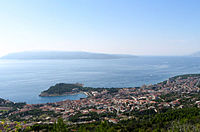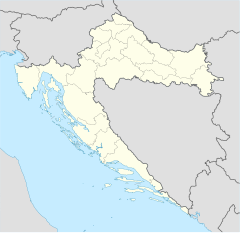Makarska
| ||
| County | Split-Dalmatia County | |
|---|---|---|
| Area | 28 km² | |
| Geographic Coordinates | 43°18′N 17°02′E / 43.300°N 17.033°E | |
| Population | 13,418(2004) | |
| Mayor | Siniša Srzić | |

Makarska Template:In it is a small town on the Adriatic coastline of Croatia, about 60 km southeast of Split and 140 km northwest of Dubrovnik. Administratively Makarska has the status of a town and it is part of the Split-Dalmatia county.
It is a tourist centre, located on a horseshoe shaped bay between the Biokovo mountain and the Adriatic Sea. The city is noted for its palm-fringed promenade, where fashionable cafés, bars and boutiques overlook the pretty harbour where many pleasure craft are moored. Adjacent to the beach are several large capacity hotels as well as a camping ground.
The center of Makarska is an old town with narrow stone-paved streets, a main church square where there is a flower and fruit market, and a Franciscan monastery that houses a sea shell collection featuring a giant clam shell.
Makarska is the center of the Makarska riviera, popular tourist destination under the Biokovo mountain. In the summertime tens of thousnds of tourists flock to the area from Germany, Austria, Czech Republic, Slovakia, Sweden, Slovenia, Hungary, Bosnia and Herzegovina as well as other countries.
History
The area of Makarska was inhabited by the Illyrians. The city appeares in the Tabula Peutingeriana as the port of Inaronia, but is mentioned as Muccurum in a document of the synod held in the Salona (533), when also the town's diocese was created.
In the 7th century the region between the Cetina and Neretva was occupied by the Slavs, who established the Neretva Principality, with Makarska as its administrative centre. The doge of Venice Pietro I Candiano, whose Venetian fleet aimed to punish the piratesque activities of the city's vessels, was defeated here on September 18, 877.
The principality was annexed to the Kingdom of Croatia in the 12th century, and was conquered by the Republic of Venice a century later. In the late 15th century the Ottomans conquered Makarska (cited by this name for the first time in 1502), sourrounding it with walls provided with three towers, not disappeared. After the return tunder the Venetian aegis from 1646, it was given to the Austrians by the Treaty of Campo Formio (1797). In 1805-1815 it was under French rule, which brought cultural, social and economic development. The Congress of Vienna assigned Makarska to Austria-Hungary, under which it remained until 1918.
In the early 20th century agriculture, trade and fishing remained the mainstay of economy. In 1914 the first hotel was built, beginning the tourism tradition in the area.
Main sights
- St. Mark's Cathedral (17th century), in the Main Square.
- Statue of the friar Andrija Kačić Miošić by the famous Croatian sculptor Ivan Rendić.
- St. Philip's Church (18th century).
- St. Peter's church (13th century), situated on the homonymous peninsula, rebuilt in 1993.
- The Franciscan monastery (16th century). It houses a library with numerous books and rare incunabula's and a famous, world known collection of shells from all over the world, collected in a Malacological Museum from 1963.
- Napoleon monument, erected in the honour of the French Marshall Marmont in 1808.
- The Baroque Ivanisevic Palace.
- Villa Tonolli, which is home to the Town Museum.
External links
- Largest Makarska guide on the Net
- Accommodation in Makarska
- Info/Accommodation/Travel/
- Ivica Batinic Homepage - First in Town!
- History of Makarska
- Nightlife in Makarska
- Info and accommodation in Makarska riviera
- Makarska Nightlife Information
- Makarska Riviera Travel Portal
- Makarska accommodations and tourist info
- Accommodation in Makarska
- Events in Makarska
- TV Makarska
- Private Apartments in Makarska
- Makarska city online interactive guide
- Private Apartments Delac in Makarska



